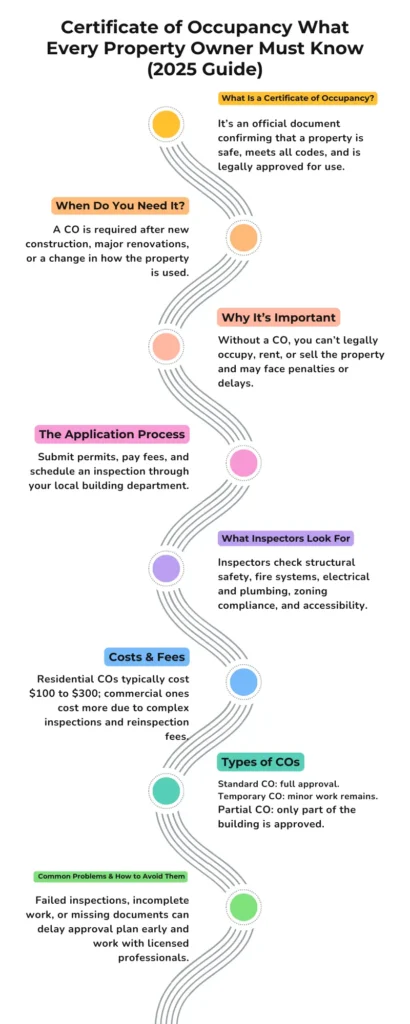What Is A Certificate Of Occupancy: Complete Guide 2025


Table of Contents
ToggleWhen you buy, sell, rent, or even renovate a property, one document becomes essential to ensure everything is legal and safe: the Certificate of Occupancy. The local building department issues this document to verify that a property complies with all safety, structural, and zoning regulations. Without it, you cannot legally live in, rent out, or operate a business from the building.
In 2025, with building codes becoming stricter, securing a CO has become even more critical. For property owners, this certificate provides peace of mind. For buyers and investors, it acts as proof that the property they are dealing with is legally habitable and compliant.
A Certificate of Occupancy (CO) is an official document that verifies a building is safe to use. It serves as proof that the property meets local building codes, safety requirements, and zoning regulations. It’s required in several situations:
Unlike building permits, which allow construction, the CO is the final approval confirming that everything was done correctly and safely.
The CO is not just paperwork; it has real legal and practical importance. Without it, you might face fines, be unable to sell or rent your property, or even risk eviction notices. It serves three critical purposes:
Put, no matter how well built or renovated a property is, it’s not considered complete without this certificate.
Requirements vary by city and state, but the core standards remain consistent everywhere. Authorities check for:
In 2025, many jurisdictions will have added energy efficiency and environmental compliance as part of the inspection.
Obtaining a CO involves several steps. Property owners begin by applying through the local building department and providing all necessary permits and documentation. Then an inspector is scheduled to visit the property. The inspector checks every aspect of the building for compliance.
If the inspection is successful, the CO is issued. If issues are found, corrections must be made before reinspection. The process can take anywhere from a few weeks to several months, depending on the property’s size, complexity, and how fast any problems are addressed.
To avoid failed inspections and delays, owners should prepare with a checklist that includes:
Following this checklist greatly improves the likelihood of passing the inspection on the first attempt.
The final approval verifies that the property complies with all codes and is ready to be occupied.
Issued when minor work is still incomplete, but the building is safe to use. It comes with an expiration date and requires final approval afterward.
Allows part of a building such as one section of an apartment complex to be occupied while other areas are still under construction.
To obtain a CO, property owners must:
Hiring experienced contractors and ensuring all documentation is complete can speed up this process.
Costs depend on property type and jurisdiction. Residential properties may pay between $100 and $300, while commercial properties may incur higher fees due to additional inspections. Reinspection fees also apply if the property fails the initial check. Though these costs may seem small, they are critical for legal compliance.
Inspections are the most crucial part of the process. Inspectors examine everything from stair railings to fire exits. They also verify that construction matches approved plans. Common reasons for failing include missing safety equipment, unauthorized modifications, or incomplete construction. Addressing these issues beforehand prevents delays.
Homeowners need a CO when building new homes, adding major extensions, or converting spaces like basements into legal apartments. Without it, selling or renting becomes difficult, as lenders and buyers demand proof that the property is legally habitable.
Commercial properties undergo stricter checks. Beyond safety and structural integrity, they must meet accessibility and zoning rules for business operations. Running a business without a CO can result in fines, legal action, or even being shut down.
Most COs do not expire unless the property undergoes major renovations or changes in use. However, temporary certificates have an expiry date. If the work is not completed by then, the owner must apply for renewal or risk penalties.
The local building department or code enforcement agency is responsible for issuing COs. Inspectors conduct evaluations, and only after passing all checks is the certificate granted. The process guarantees that buildings comply with all legal and safety requirements.
Owners frequently face problems like failed inspections, missing documents, or zoning conflicts. The best way to avoid these issues is to prepare early, hire qualified contractors, and keep communication open with local authorities. Addressing potential problems in advance saves time and prevents costly reinspections.
These figures show that proper preparation is critical to securing a CO without unnecessary delays.
The Certificate of Occupancy is more than just a piece of paper. It’s legal proof that your building is safe and compliant. Without it, you risk fines, delays in selling or renting, and even legal action. For homeowners, landlords, and business owners, this document is essential for peace of mind and smooth property transactions.